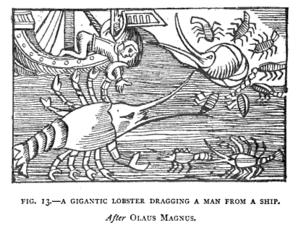
Kraken
The kraken (/ˈkrɑːkən/)[7] is a legendary sea monster of enormous size, etymologically akin to a squid or octopus, said to appear in the sea between Norway and Iceland. It is believed the legend of the Kraken may have originated from sightings of giant squid, which may grow to 12–15 m (40–50 feet) in length.
For other uses, see Kraken (disambiguation).
Kraken, as a subject of sailors' superstitions and mythos, was first described in the modern era in a travelogue by Francesco Negri in 1700. This description was followed in 1734 by an account from Dano-Norwegian missionary and explorer Hans Egede, who described the kraken in detail and equated it with the hafgufa of medieval lore. However, the first description of the creature is usually credited to the Danish bishop Pontoppidan (1753). Pontoppidan was the first to describe the kraken as an octopus (polypus) of tremendous size,[b] and wrote that it had a reputation for pulling down ships. The French malacologist Denys-Montfort, of the 19th century, is also known for his pioneering inquiries into the existence of gigantic octopuses (Octupi).
The great man-killing octopus entered French fiction when novelist Victor Hugo (1866) introduced the pieuvre octopus of Guernsey lore, which he identified with the kraken of legend. This led to Jules Verne's depiction of the kraken, although Verne did not distinguish between squid and octopus.
Linnaeus may have indirectly written about the kraken. Linnaeus wrote about the Microcosmus genus (an animal with various other organisms or growths attached to it, comprising a colony). Subsequent authors have referred to Linnaeus's writing, and the writings of Bartholin's cetus called hafgufa, and Paullini's monstrum marinum as "krakens".[c] That said, the claim that Linnaeus used the word "kraken" in the margin of a later edition of Systema Naturae has not been confirmed.
General description and myth[edit]
In Norwegian sailor folklore, kraken ("the krake" or "the crookie"), also known as horven (among others), is a legendary sea monster said to appear in the sea between Norway and Iceland.
It is said that when fishermen row out a few miles (Scandinavian miles) from the coast on a hot summer's day in a calm, and according to normal calculations should find a depth of 80–100 fathoms (140–180 metres (460–590 ft) deep), it sometimes happens that the plummet bottoms at 20–30 fathoms (35–50 metres (115–164 ft) deep). But in this water stand the most abundant shoals of cod and lings. Then you can assume that the kraken lurks down there; as it is he who forms the artificial elevation of the bottom and by his secretions attracts fish there. But if those fishing notices that the kraken is rising, it is necessary to row away for all the boat can take. After a few minutes, the beast can then be seen lifting the upper part of its body above the surface of the water, which for a quarter of a mile (ca 1.5 mi.) in circumference appears as a collection of skerries, covered with swaying, seaweed-like growths. Finally, a few shining tentacles rise up in the air, increasingly thicker at the bottom, which can even appear as high as ship's masts. After a while, the kraken gives in to sinking again, and you then have to be careful not to run into the suction vortex that is formed.[17]
Egede[edit]
The krake (English: kraken) was described by Hans Egede in his Det gamle Grønlands nye perlustration (1729; Ger. t. 1730; tr. Description of Greenland, 1745),[50] drawing from the fables of his native region, the Nordlandene len of Norway, then under Danish rule.[52][53]
According to his Norwegian informants, the kraken's body measured many miles in length, and when it surfaced it seemed to cover the whole sea, and "having many heads and a number of claws". With its claws it captured its prey, which included ships, men, fish, and animals, carrying its victims back into the depths.[53] Egede conjectured that the krake was equatable to the monster that the Icelanders call hafgufa, but as he had not obtained anything related to him through an informant, he had difficulty describing the latter.[42][l]
According to the lore of Norwegian fishermen, they could mount upon the fish-attracting kraken as if it were a sand-bank (Fiske-Grund 'fishing shoal'), but if they ever had the misfortune to capture the kraken, getting it entangled on their hooks, the only way to avoid destruction was to pronounce its name to make it go back to its depths.[55][56] Egede also wrote that the krake fell under the general category of "sea spectre" (Danish: søe-trold og [søe]-spøgelse),[58] adding that "the Draw" (Danish: Drauen, definite form) was another being within that sea spectre classification.[24][56][m]
![Kraken represented as a Crayfish or Lobster.[189] Monster "M". Carta marina (1539), detail.](http://upload.wikimedia.org/wikipedia/commons/thumb/5/58/Carta_Marina_-polypus_as_lobster_snatches_man.jpg/296px-Carta_Marina_-polypus_as_lobster_snatches_man.jpg)

![Giant fish encountered by St. Brendan. "Insula Fortunata" marked near it.[186]](http://upload.wikimedia.org/wikipedia/commons/thumb/c/cd/Houghton_Typ_620.22.697_-_Nova_typis_transacta_navigatio.jpg/372px-Houghton_Typ_620.22.697_-_Nova_typis_transacta_navigatio.jpg)